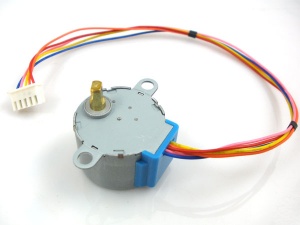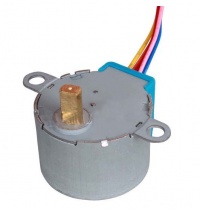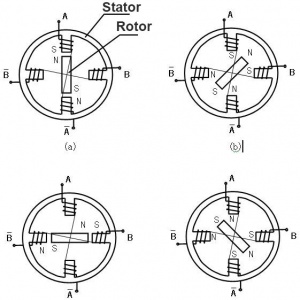Stepper Types
Stepper Introduction
A stepper motor is an electromechanical device which converts electrical pulses into discrete mechanical movements. The shaft or spindle of a stepper motor rotates in discrete step increments when electrical command pulses are applied to it in the proper sequence. The motors rotation has several direct relationships to these applied input pulses. The sequence of the applied pulses is directly related to the direction of motor shafts rotation. The speed of the motor shafts rotation is directly related to the frequency of the input pulses and the length of rotation is directly related to the number of input pulses applied.One of the most significant advantages of a stepper motor is its ability to be accurately controlled in an open loop system. Open loop control means no feedback information about position is needed. This type of control eliminates the need for expensive sensing and feedback devices such as optical encoders. Your position is known simply by keeping track of the input step pulses.
Understand the pin defintion of stepper Motor
From the picture above we can know that the A and ~A are connected, B and ~B are connected, so let's say A and ~A are group a, B and ~B are group b.
Whether two-phase four-wire, four-phase five-wire, four-phase six-wire stepper motor. Internal structure is the same. As to whether it is four , five, or six lines, depends on whether there are comm line between A and ~A, B and ~B. If group a and b each have a com-side, then it is the six-wire stepper motor, if a and b group together common terminal, it is five lines.
Therefore, to understand how the stepper motor wiring, just need to separate group a and b by using a multimeter.
Four-wire
Four-wire without the com common pumping line, so, a and b groups are absolutely insulated, not communicating. Therefore, measured with a multimeter, not connected to a group.
Five-wire
For five lines, the a and b group common terminal are connected together. Measured with a multimeter, when the line with other lines have the all the same value, then, this line is in the public com side. For the five-wire stepper motor drives, leaving com-side not wired is possible to drive a stepper motor.
Six-wire
- The comm line of group a and b is not connected in this case.
- Firstly, need to separate the six line into two groups, three the lines have connection to each other should be in a group, and other three which can't connect to these three should be another group.
- Similarly, the measured resistance with a multimeter and found a line and the other two lines stop is the same, then this line is com-side, and the other two lines belong to a group. For the six-lane four-phase stepper motor, two comm lines does not connected can also drive the stepper motor.
Connection of four phase six wires stepper
- Connect two groups to normal signal pins, and leave two common lines NC, then in this case the stepper run as a two phase and four wires motor
- Connect two comm lines connect to VCC, and two groups connect to normal signal pins, then the stepper run as a normal four phase, six wires motor.
- Note: The comm line should connect to the VCC power supply pin.


